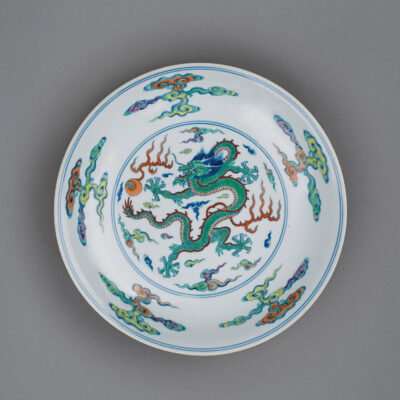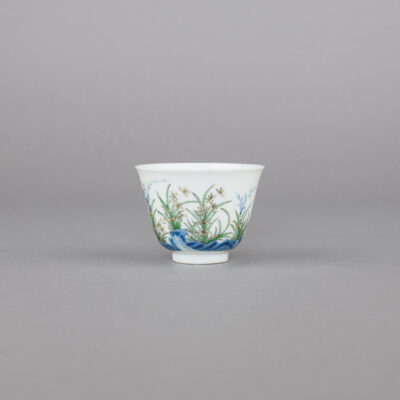13 – M5094
Description
Chinese imperial porcelain doucai dragon saucer dish, pan, painted in the centre with a five-clawed dragon with open mouth and detailed scales in pursuit of a large iron-red flaming pearl, amongst stylised flames and ruyi-clouds all within two underglaze blue lines, the cavetto painted with five large ruyi-clouds in iron-red, aubergine, green and yellow enamels outlined in underglaze blue within two further underglaze blue lines beneath the rim. The underside with a wide band of crested foaming waves beneath clouds, all within underglaze blue double lines.
The base with a six-character mark of Yongzheng within a double ring in underglaze blue and of the period, 1723-1735.
7 ⅞ inches, 20 cm diameter.
Provenance & Additional Information
- From the collection of Herbert Carmichael (1914-1986), collection 374, original inventory no. 1800. The Carmichael family, East Yorkshire, owned the famous department store, Carmichael’s, often referred to as the “Harrods of the North”. There were four Carmichael brothers who owned the business and this dish came from direct descent through the nephew of one of the four brothers, Herbert Carmichael, who gifted pieces to the Worcester Museum. Herbert retired in the 1960s when the family sold the business and moved to Scarborough. His collection was left to his daughter and then to his nephew who was the last inheritor. The nephew had the original inventory list when the family lived at Hotham Hall and this dish still has the label with collection no. 374.
- The pair to this dish was sold by Sotheby’s Hong Kong in their auction of Important Chinese Art, 9th October 2020, lot 3634, 78/9.
- A smaller saucer dish of this design in the collection of the Hong Kong Museum of Art is illustrated by Christina Chu in The Wonders of the Potter’s Qing Ceramics from the Collection of the Hong Kong Museum of Art, Hong Kong, 1984, no. 45, pp. 84/5.
- It is exceptionally rare to find Yongzheng doucai saucers dishes painted with a striking dragon design of this large size, no others apart from the pair to this dish mentioned above appear recorded.
- Ruyi-form clouds, ruyi yun, are depicted here as a colourful wish-granting motif, with the ascending dragon representing good Clouds symbolise the granting of all wishes. The wide band of crested waves on the underside is a Ming motif alluding to the sea as the traditional abode of dragons. Water, flowing down from the high mountains, shan gao shui chang, is a visual rebus for eternity and the never-ending abundance of time.











